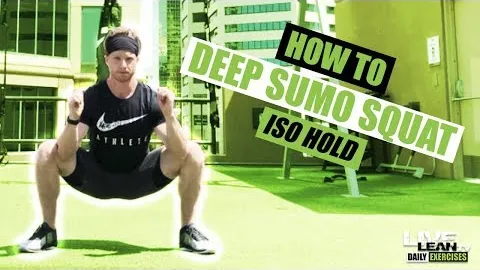
When it comes to building lower body strength, the deep sumo squat isolation hold is an exercise that should not be overlooked. This powerful move engages your quadriceps, glutes, hamstrings, and calves, helping you develop a strong and well-defined lower body. In this article, we will delve into the technique, benefits, variations, and tips to maximize your results with this exercise.
The deep sumo squat isolation hold, also known as the sumo squat pause or sumo squat static hold, is a variation of the traditional sumo squat exercise. While the sumo squat primarily targets the inner thighs, the isolation hold takes it a step further by adding an isometric component to the movement.
To perform the deep sumo squat isolation hold, start by standing with your feet wider than shoulder-width apart and your toes pointing outwards. Lower yourself into a squat position by bending your knees and pushing your hips back. Go as deep as possible while maintaining good form, then hold the bottom position for a specific duration of time, usually between 10 to 30 seconds.
Incorporating deep sumo squat isolation hold into your workout routine can yield several benefits. Here are some key advantages:
Increased Lower Body Strength: The deep sumo squat isolation hold targets the muscles of the lower body, including the quadriceps, glutes, hamstrings, and calves. By holding this position, you engage these muscles isometrically, promoting strength and stability.
Improved Muscular Endurance: Holding the deep sumo squat position for an extended period challenges your muscular endurance. By increasing the time you spend in the hold, you gradually build endurance and stamina in your lower body muscles.
Enhanced Flexibility: The deep sumo squat isolation hold requires a significant range of motion in the hips, knees, and ankles. Regularly performing this exercise can improve your lower body flexibility over time.
Core Activation: To maintain proper form throughout the deep sumo squat isolation hold, you need to engage your core muscles. This exercise helps strengthen your core and promotes better stability in your torso.
Improved Posture: Engaging the muscles of the lower body and core during the deep sumo squat isolation hold can improve your overall posture. Strengthening these muscles helps support your spine and encourages proper alignment.
To keep your workout routine challenging and prevent plateaus, you can try various variations of the deep sumo squat isolation hold:
Weighted Deep Sumo Squat Hold: Hold a dumbbell or kettlebell with both hands at chest level while performing the deep sumo squat isolation hold. The added resistance increases the intensity and further strengthens your lower body muscles.
Pulsing Deep Sumo Squat Hold: Instead of holding the bottom position statically, perform small squat pulses while in the deep sumo squat position. This variation increases the time under tension and adds an explosive aspect to the exercise.
Single-Leg Deep Sumo Squat Isolation Hold: This variation focuses on one leg at a time, challenging your balance and stability. Lift one leg off the ground and hold the deep sumo squat position on the opposite leg. Switch legs after completing the desired hold time.
Elevated Deep Sumo Squat Hold: Place your heel on an elevated surface, such as a step or platform, while performing the deep sumo squat isolation hold. This variation increases the range of motion and adds an extra challenge to the exercise.
To get the most out of your deep sumo squat isolation hold, keep the following tips in mind:
Maintain Proper Form: Focus on keeping your back straight, chest lifted, and knees tracking over your toes throughout the exercise. Avoid rounding the back or letting the knees cave inwards.
Controlled Descent: Lower yourself into the deep sumo squat position slowly and under control. This ensures that you engage the target muscles effectively and reduce the risk of injury.
Breathe: Remember to breathe steadily during the hold. Inhale deeply through your nose before descending into the squat and exhale slowly through your mouth as you hold the position.
Increase Hold Time Gradually: Start with a comfortable hold time, such as 10 seconds, and gradually increase it as your strength and endurance improve. Aim for 20 to 30 seconds per hold for maximum benefits.
Proper Warm-up: Before performing the deep sumo squat isolation hold, warm-up your lower body with dynamic stretches or light exercises like walking lunges or bodyweight squats.
The deep sumo squat isolation hold is a valuable exercise for building lower body strength, improving muscular endurance, and enhancing flexibility. By incorporating variations and following proper form and technique, you can maximize the benefits and achieve your fitness goals. Remember, consistency and gradual progression are key to successfully incorporating this exercise into your routine. So, lace up your sneakers, give it a try, and start reaping the rewards of a strong and sculpted lower body.
If you're looking for a gym, fitness club or yoga studio, you've come to the right place.
You can find information about gyms in your area. Browse catalog of gyms and find gyms with classes which are you looking for.
On gym page you can find simple information like address, phone or website. You can find list of available classes. You can check availability of personal training or small group classes. On place page you can also see information about open hours.
You can find gyms near you with amenities, courts, studios and equipments.
Use our map to find gym at your city or district.
In Gym Navigator you can find list of exercises with movies for many body parts.
You can browse exercises catalog and find exercises the best of you.
You can also find exercises grouped into workout plans, which you can use to improve you body. Each routine show you exercises one by one and give you possibility to count you progress and count down rest time.